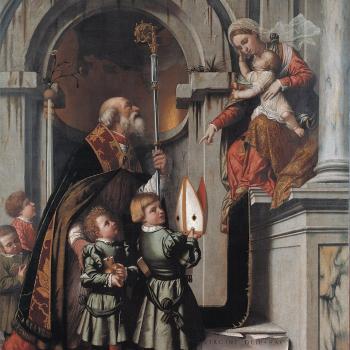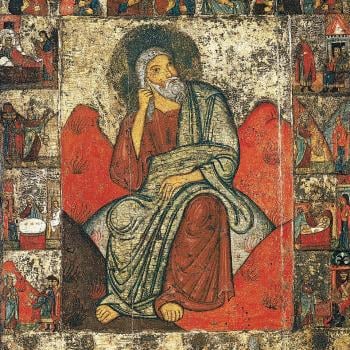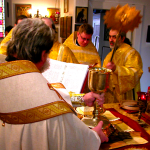
God’s eternal activity, God’s uncreated energy, can be engaged by us; if we welcome it in our lives, we will receive grace, and not just any kinds of grace, but deifying grace. With it, we will end up being transfigured like Christ was at Mount Tabor. What the apostles saw on Mount Tabor was both the hidden glory of the incarnate God-man made manifest, but also, the blessed light of grace which can be taken in and incorporated by all things, the grace which grants all things to have a share in the divine life. The light was seen shining through Christ’s body, revealing one of the key elements of the Christian faith: material being, and not just spiritual being, is loved and affirmed by God. The body has a place in eternity, which is why it also is able to share in our deification; this is one of the basic principles of orthodoxy Christianity which separates it from its Gnostic imitators because the Gnostics thought matter was evil and had no place with the good God::
Without the transfiguration of the material world into a fact of relationship and the starting-point for a relationship, the Christian ethic no longer looks towards the existential “changing” of man, the salvation of life from corruption and death. It turns into an idealistic system which, like all idealism, is inevitably conventional and essentially irrelevant to real life and its problems. [1]
The incarnation shows us that material being matters, that matter itself matters, and because matter matters, what happens in and with it likewise matters: our actions in the world have value, and because they do, we are obligated to act for the sake of justice for those who unjustly suffer in the midst of temporal existence:
The Christian gospel is God’s message of liberation in an unredeemed and tortured world. As such, it is a transcendent reality that lifts our spirits to a world far removed from the suffering of this one. It is an eschatological vision, an experience of transfiguration, such as Jesus experienced at his Baptism (Mk 1:9-11) or on Mt. Tabor (Mk 9:2-8), just before he set out on the road to Jerusalem, the road that led to Calvary. [2]
The transfiguration is an eschatological event. The glory of the kingdom of God is found among us; we are shown the immanentization of the eschaton. Thanks to the transfiguration, we not only learn of the hidden glory of Jesus, of his divinity, but also the hidden dimension of God’s work with creation. The kingdom of God penetrates the world and showers with it the radiant grace of Tabor, the enlightening and deifying grace of God. The eschatological kingdom is something which we can participate in and experience now, even as we will find our experience of it can grow, and will grow, until it is fully realized by us in our entry into eternal life:
Eternal life, the grace-bestowing vision of the kingdom of God, is available in this world, according to the meaning of this dogma; it is as if a new ascent to Mount Tabor and contemplation of the Lord’s glory takes place. The power of the transfiguration is the kingdom of God, and the “some” who did not taste death before they saw the kingdom of God are not only the disciples but all who commune in eternal life and who are expressly honored with the vision of God’s glory.[3]
Peter, James and John were witnesses to the transfiguration on Mount Tabor, but they were not the only ones, as Moses and Elijah were there with them. The law and the prophets, represented by Moses and Elijah, were and continue to be witnesses of the glory of God. They were all “were eyewitnesses of his majesty” (2 Ptr. 1:16b RSV). This is not to say any one of them, in their apprehension of it, comprehended the glory – for obviously none of them did (represented by the way Moses is said to have seen the back and not the front of God). Each of them apprehended something different, something which complements the rest, which is why they all serve as witnesses which should be listened to and acknowledged.
This is truly the practical lesson we should learn from the transfiguration: the glory of God is with us and it is something which we can apprehend; when we do so, we should let it change us, becoming better persons. If we do so, we will serve as witnesses of the kingdom of God to others. The more we apprehend, the more we can share with others.
God has been and always will be engaging creation, always doing what can be done to bring it together as one integral whole. The transfiguration shows this in the way Moses, Elijah, and the apostles came together, representing the way the Law, the prophets, and the Christian tradition should work with and serve each other. This is why the transfiguration can be said to even hint to the great truth, the great secret of God, that the world and all that is in it will not be annihilated but transfigured, brought together as one into the kingdom of God:
Our world will not be annihilated, but transfigured. Through the Incarnation, Jesus not only lived upon this material earth, but He began the process of recapitulating all things according to His Father’s plan.[4]
Annihilationism denies the glory of God, and God’s work; dualism denies the glory of God and God’s work. Orthodox Christianity denies both errors as it teaches that the glory of God is shared with all things, material and spiritual, so that the kingdom of God can be seen in all things, and if it can be seen and experienced in all things, then all things should be and will be preserved by God.
[1] Christos Yannaras, The Freedom of Morality. Trans. Elizabeth Briere (Crestwood, NY: St. Vladimir’s Seminary Press, 1984), 87.
[2] James H. Cone, The Cross and the Lynching Tree (Maryknoll, NY: Orbis Books, 2011), 155.
[3] Sergius Bulgakov, “On the Kingdom of God” in The Sophiology of Death. Essays on Eschatology: Personal, Political, Universal. Trans. Roberto J. De La Noval (Eugene, OR: Cascade Books, 2021), 13.
[4] George Maloney, SJ, God’s Exploding Love (New York: Alba House. 1987), 162.
Stay in touch! Like A Little Bit of Nothing on Facebook.
If you liked what you read, please consider sharing it with your friends and family!
N.B.: While I read comments to moderate them, I rarely respond to them. If I don’t respond to your comment directly, don’t assume I am unthankful for it. I appreciate it. But I want readers to feel free to ask questions, and hopefully, dialogue with each other. I have shared what I wanted to say, though some responses will get a brief reply by me, or, if I find it interesting and something I can engage fully, as the foundation for another post. I have had many posts inspired or improved upon thanks to my readers.












